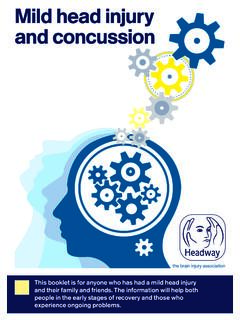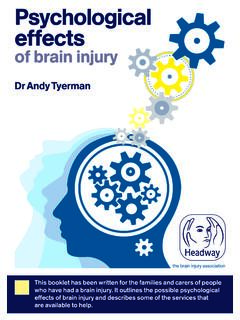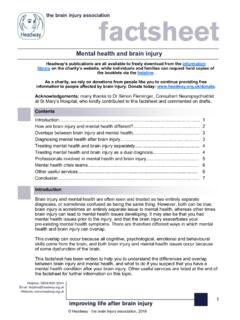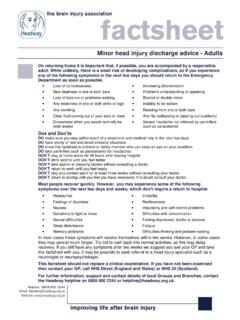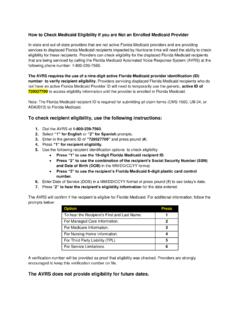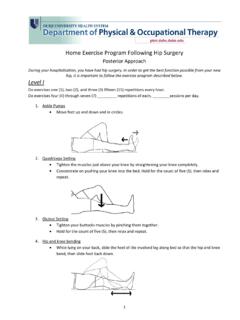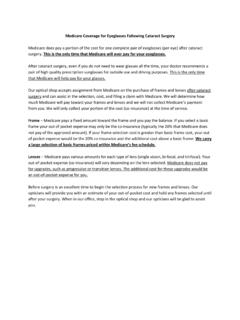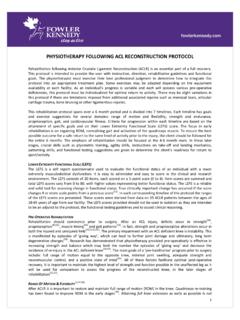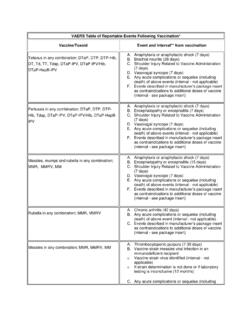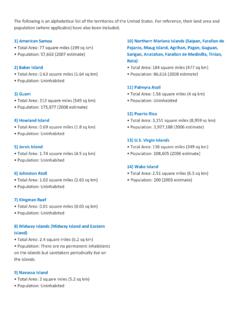Transcription of Rehabilitation following acquired brain injury - Headway
1 Rehabilitation following acquired brain injury National clinical guidelines BSRM Royal College British Society of Rehabilitation Medicine of Physicians The guidelines were prepared by a multidisciplinary The guidelines are working party convened by the British Society of published in collaboration with the Clinical Rehabilitation Medicine (BSRM). They were drafted Effectiveness and and edited by Professor Lynne Turner-Stokes on Evaluation Unit, Royal behalf of the British Society of Rehabilitation Medicine College of Physicians and the Royal College of Physicians. 2003. Acknowledgements Financial support for the preparation of this document was kindly provided by: The British Society of Rehabilitation Medicine (BSRM).
2 The Department of Health Research and Development funding programme An academic support grant from the Luff Foundation. The Royal College of Physicians and the BSRM would like to acknowledge the enormous contribution in terms of time and effort which was given by members of the working party. We are also grateful to members of the advisory group and other individuals who have provided constructive comments on successive drafts. Finally, we are grateful to Sandy Weatherhead of the BSRM and Helen Salgo of King's College London for secretarial assistance and superb organisation skills, and to Kanchana Jeganathan of King's College London for reference retrieval. Citation of these guidelines should be as follows: Royal College of Physicians and British Society of Rehabilitation Medicine.
3 Rehabilitation following acquired brain injury : national clinical guidelines (Turner-Stokes L, ed). London: RCP, BSRM, 2003. BRITISH SOCIETY OF Rehabilitation MEDICINE. c/o Royal College of Physicians 11 St Andrews Place, London NW1 4LE. Registered charity No 293196. ROYAL COLLEGE OF PHYSICIANS. 11 St Andrews Place, London NW1 4LE. Registered charity No 210508. Copyright 2003 Royal College of Physicians of London ISBN 1 86016 194 4. Typeset by Dan-Set Graphics, Telford, Shropshire Printed in Great Britain by The Lavenham Press, Sudbury, Suffolk ii The Royal College of Physicians of London The Royal College of Physicians aims to promote the highest standards of medical practice in order to improve health and healthcare.
4 To achieve this it seeks to: set and improve standards for clinical practice support physicians in their practice of medicine promote and provide continuing professional development throughout a doctor's career advise the government, the public and the profession on healthcare issues. It defines and monitors programmes of education and training for physicians, and sets examinations including the MRCP(UK) qualification required of UK graduates before they can enter specialist training. It has over 11,000 Fellows worldwide. The Clinical Effectiveness and Evaluation Unit (CEEU). The Clinical Effectiveness and Evaluation Unit of the Royal College of Physicians concentrates on those issues that are at the centre of the national healthcare agenda, eg the National Service Frameworks in Cardiology, Care of Older People and Diabetes, and the Calman-Hine Cancer Framework, as a continuous programme of work rather than multiple one-off projects.
5 Associate Directors, who are active clinicians in their field, lead the relevant programmes in conjunction with the Director. The CEEU has expertise in the development of guidelines, the organising and reporting of multi-centre comparative audit to encourage guideline implementation, and studies on how the outcome of care can be measured reliably. All our work is collaborative with relevant specialist societies, patient groups and health service bodies such as the National Service Frameworks, National Institute for Clinical Excellence and the Commission for Health Audit and Inspection. The CEEU is self-financing with funding coming from government, charities and other organisations. The British Society of Rehabilitation Medicine The British Society of Rehabilitation Medicine is the UK professional organisation for practitioners in Rehabilitation medicine.
6 It is a young, vibrant organisation devoted to: promoting the development and good practice of Rehabilitation medicine as a medical specialty enhancing undergraduate and postgraduate education in Rehabilitation and disability issues supporting Rehabilitation research working with related medical, paramedical and voluntary organisations to further these aims. Membership is open to registered medical practitioners with an interest in disability and its management. iii Contents Foreword vii Executive summary ix DEVELOPMENT OF THE GUIDELINES AND BACKGROUND. The process of guideline development 3. Overall objective 3. Target audience 3. Scope 4. The guideline development group 4. Conflicts of interest 4. Evidence to support the guidelines 4.
7 Implementation and cost implications 6. Updating and review 6. Terminology 6. Background 7. Definitions 7. Epidemiology 8. Sequelae of mild traumatic brain injury 8. Presentation to Rehabilitation services 9. Main stages of Rehabilitation 10. Rehabilitation team processes 11. Coordination and communication 12. THE GUIDELINES. 1 Principles and organisation of services 15. The provision of specialist services 15. Commissioning, planning and development of services 15. Rehabilitation service networks 16. Coordination of Rehabilitation for individual cases within the network 17. Timing, intensity and duration of treatment 18. Staffing levels to meet demands for intensive treatment 18. 2 Approaches to Rehabilitation 21.
8 Teamwork and communication 21. Goal planning 22. Assessment and measurement 22. 3 Carers and families 23. 4 Early discharge and transition to Rehabilitation services 25. Early discharge to the community 25. Transfer to Rehabilitation 26. 5 Inpatient clinical care preventing secondary complications in severe brain injury 28. Optimising respiratory function 28. Management of swallowing impairment 29. v Contents Maintaining adequate nutrition and hydration 30. Positioning and handling 30. Effective bladder and bowel management 32. Establishing basic communication 32. Managing epileptic seizures 33. Emerging from coma and post-traumatic amnesia 33. Prolonged coma and vegetative states 34. 6 Rehabilitation setting and transition phases 35.
9 Referral, assessment and review 35. Discharge planning 36. 7 Rehabilitation interventions 38. Promoting continence 38. Motor function and control 39. Sensory disturbance 41. Communication and language interventions 42. Cognitive, emotional and behavioural management 43. Optimising performance in daily living tasks 46. Leisure and recreation 48. Computers and assistive technology 48. Driving 49. Vocational/educational Rehabilitation 50. 8 Continuing care and support 52. General principles 52. Joint health and social services provision 53. 9 The need for further research 55. Epidemiological data 55. Service mapping 55. Timing and intensity 55. Outcomes 56. Cost effectiveness of Rehabilitation 56. Summary 56.
10 References 57. Appendix 1 Guideline development group membership 64. Working party membership 64. Advisory group membership 65. Conflicts of interest 66. Collaborating organisations 67. Inter-agency advisory group on vocational Rehabilitation 68. Appendix 2 Standards document 69. Standards for acquired brain injury and related disorders 69. Standards for general conditions of relevance to the guidelines 71. Appendix 3 Useful addresses 73. Appendix 4 Summary guidelines for early discharge to the 74. community and referral to Rehabilitation vi Foreword We are pleased to be publishing these timely national clinical guidelines for Rehabilitation following acquired brain injury . They provide a comprehensive framework for the management of an important patient group and complement the guidelines on the management of head injuries, published by the National Institute for Clinical Excellence (NICE) in June 2003.

